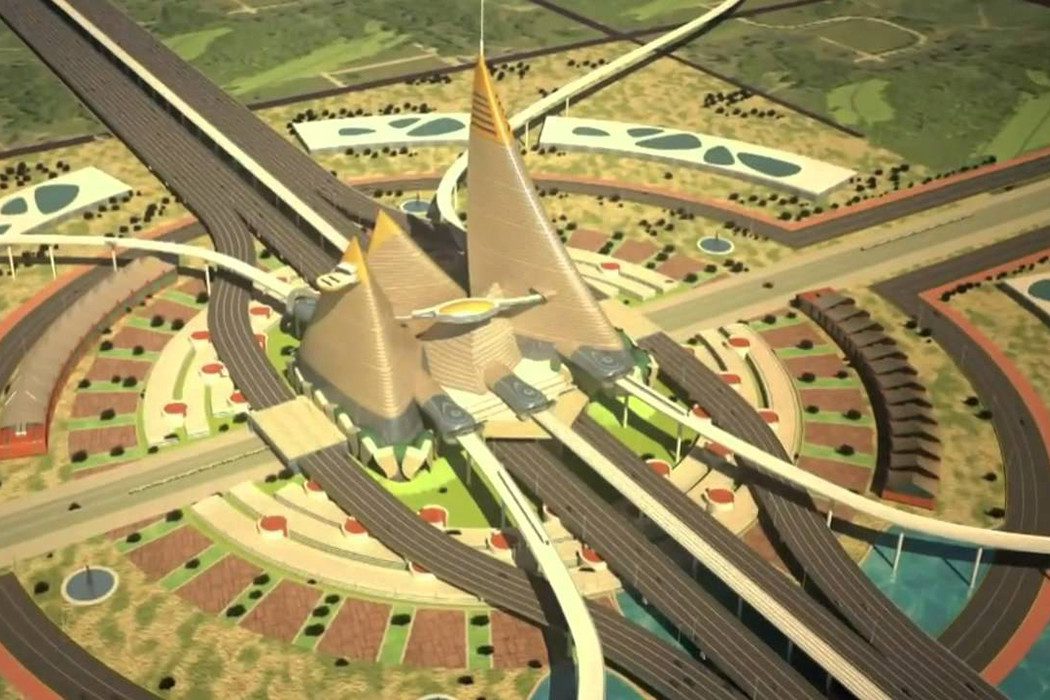The shared logic of SEZs and Smart Cities must be rejected if we are to avoid a dystopian future.
I have seen the future, and there are no motorcycles. No bicycles either, nor buses. There are few pedestrians, and all of them seem to be white. Lots of cars, though. And shiny Metro trains. And airplanes and helicopters and yachts. And swimming pools galore.
This vision was brought to me by the Gujarat Infrastructure Development Board (GIDB), through its video ‘Dholera SIR – FUTURE SMART CITY’. The GIDB was established in 1995 in order to facilitate Public-Private Partnerships (PPPs) in the infrastructure sector. Dholera is one of its biggest projects, an enormous industrial township to be conjured out of thin air. The Special Investment Region (SIR) of Dholera was notified in 2009, and it finally got its environmental clearance in August 2014. GIDB’s promotional video for Dholera shows a futuristic landscape, rendered in remarkably low-quality computer animation, replete with glittering skyscrapers, multi-lane highways, mega-malls, tree-lined walkways, perfectly-manicured lawns, and—at the centre of it all—the proposed Gujarat Trade Centre, which bears a striking resemblance to a villain’s lair in a sci-fi film.
And there is something villainous about these plans. There is little place in this gleaming city for the vast majority of Indians, who cannot afford the cars and luxury apartments featured in the video, and who do not fit the “global citizen” image the new city seeks to portray. It certainly has no place for the farmers whose land is to be forcibly acquired to make way for city. The farmers themselves know this, and have been protesting against the state government for years.
There is something villainous about these plans. There is little place in this gleaming city for the vast majority of Indians, who cannot afford the cars and luxury apartments featured in the video, and who do not fit the “global citizen” image the new city seeks to portray.
But this is old news. The Dholera video was released in June 2013, and the last news report of any protest was published in September 2014. Still, the video has ominous implications for the present day. Dholera is advertised as “A New Gujarat within Gujarat”, vigorously backed by then-chief minister Narendra Modi. Now, as prime minister, Modi is trying to bring this dystopian ‘New Gujarat’ to the country as a whole.
The video is even more relevant as Modi’s ‘Smart Cities’ project kicks into high gear. When Modi first announced the Smart City project, there was considerable skepticism, even in the mainstream media. One article called the scheme “a recipe for social apartheid.” The historian Janaki Nair penned a scathing critique in the op-ed pages of The Hindu, calling it “morally and socially indefensible” and a sign of the “bankruptcy of our collective urban imaginations.” Many commentators noted that the smart cities were vaguely defined, made little mention of the urban poor, and seemed poised to benefit mainly real estate developers and IT companies, with little benefit to the larger public.
But now that the actual specifics of the Smart City scheme are emerging, the media seems remarkably quiet. I am thinking particularly of the new Land Pooling Policy introduced in Delhi, which was covered in all the major newspapers, but which elicited little criticism. Many articles merely parroted the government’s talking points. A typical article in The Hindu, called ‘Making Delhi a Smart City’, repeated the government’s assertions that the Land Pooling Policy will “come to the city’s rescue” and that it is the “only way” to accommodate the city’s growing population.
Part of this lazy writing may simply be due to the complexity of the policy mechanisms involved, and the intense boredom that most readers (and reporters) likely have when faced with phrases like ‘Land Pooling Policy’. But such mechanisms are the newest weapons in the government’s drive for privatisation of public services and ‘development’ by means of land acquisition and widespread dispossession. They deserve our attention, even if the details make our eyes glaze over.
The new Land Pooling Policy targets landowners in rural parts of Delhi that the government now wants to urbanise. Under the policy, landowners are encouraged to surrender their land to the government, and in fact pay a hefty fee to the government for the honor of having their land taken away. The government, in turn, sells the land to private real estate developers, who go about ‘developing’ the land—building high-rise apartments, malls, office buildings and the like. After the ‘development’ is complete, the original landowners are given a piece of the developed land: 52 percent in some cases, 40 percent in others.
The Land Pooling Policy is, in part, a way to deflect attention away from the criticism the government has received regarding forcible land acquisition. It is a clever move, as it induces landowners to support their own dispossession; by allowing them to retain part of their land, and to potentially profit from it enormously, it may persuade them to give up much of their property and enter the heady world of real-estate speculation. Further, by outsourcing infrastructure work to private developers through the PPP model, the government can build Delhi up without taking responsibility for the actual building.
Such mechanisms are the newest weapons in the government’s drive for privatisation of public services and ‘development’ by means of land acquisition and widespread dispossession. They deserve our attention, even if the details make our eyes glaze over.
The only problem is, it won’t work. Or rather, it will work in a way that only benefits real estate developers and a small fraction of farmers who win in the casino of real-estate speculation. The Land Pooling Policy takes notice only of landowners, not of the thousands of landless workers who will get unceremoniously uprooted. Further, the Indian government is notorious for abandoning its promises when it comes to acquisition, development and compensation.
The Smart City scheme, as many have pointed out, is largely a continuation and modification of the Special Economic Zone (SEZ) scheme, which faced widespread opposition and largely failed to achieve its goal of stimulating manufacturing in India. Sixty three percent of the land acquired for SEZs now lies vacant. But the SEZs have been massively successful in turning productive agricultural land into real estate. The process is now poised to repeat itself in Delhi.
Surprisingly, the only newspaper to notice the dark side of Delhi’s new Land Pooling Policy was the poster child of neoliberal reporting, The Times of India, which published an article entitled ‘Land pooling: Farmers not keen to part with their land’. The article notes that, despite the government’s emphasis on voluntary surrendering of land, the farmers in rural Delhi feel compelled to sell. Farmers mention the policies of successive governments, which have made agriculture an unprofitable pursuit. They are also quick to point out previous government acquisitions whose benefits never materialised. Instead of surrendering their land to the government, many farmers prefer to sell to real-estate developers, which gives them a quick profit but only perpetuates the larger process of speculation-driven urban growth, which has little room for farmers.
The Land Pooling Policy takes notice only of landowners, not of the thousands of landless workers who will get unceremoniously uprooted. Further, the Indian government is notorious for abandoning its promises when it comes to acquisition, development and compensation.
This is the ugly truth that lies behind the glitter and glamour of Smart Cities. The farmers of Dholera have realised this; the farmers of Delhi are taking notice as well. And land acquisition remains a volatile issue, as recent debates in Parliament have shown. If Delhi and Dholera are to avoid a dystopian future, the shared logic of SEZs and Smart Cities must be decisively rejected.















